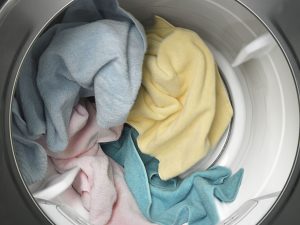A Broken Heating Element:
Electric dryers have a heating element to warm the air inside the drum, This is fundamental to drying your clothing and other items. Unfortunately, with repeated use, over time, the heating element can break. When this occurs, your dryer will not generate sufficient heat to dry your clothing. Conversely, the heating element may overheat, causing a safety threat.
You can check if your heating element is working correctly by using a multimeter to test its continuity. The ideal reading is 20 to 50 ohms, but if you have no continuity, the element will need to be replaced.
Blown Thermal Fuse:
The thermal fuse is a safety device which is typically located in the back cover panel near the exhaust duct. The primary purpose of this fuse is to prevent fires. If a dryer reaches a specific temperature and is at risk of overheating, the fuse will trip.
Unfortunately, this mechanism can also prevent your dryer from working properly. If the fuse blows, it may mean that your dryer will not generate sufficient heat to dry your items.
Thermal fuses are single use components, so once it has tripped, you will need to install a replacement.
Defective Cycling Thermostat:
The cycling thermostat regulates the temperatures inside your dryer. It is responsible for switching the heating element off and on to maintain the optimum temperature. When the thermostat develops a defect, it cannot accurately sense the temperature, which could lead to overheating or failing to heat altogether.
Faulty High Limit Thermostat:
Modern dryers typically have another type of thermostat in addition to the cycling thermostat. The high limit thermostat keeps track of the temperature to shut off the heating element if the dryer begins to overheat. If the thermostat develops a fault, the element may continue to run, generating excess heat.
Obstructed Ducting:
Clothes dryers can be ventless or vented, and if you have a vented model, it will have a ducting system to eject hot air outside your home. Unfortunately, if your duct becomes clogged, it can lead to the dryer overheating. You may notice that your clothing feels excessively hot after the drying cycle or you may even notice a burning smell.
This makes it crucial to regularly clean your ducting to remove any lint, dirt or dust that may accumulate.
Tips for Maintaining Your Dryer:
Now we’ve covered the common dryer issues, there are some tips that can help you to maintain your dryer for prolonged lifespan and efficient performance. These include:
- Keep hold of your owner’s manual: Your owner’s manual provides a wealth of information for operating your dryer. It also includes instructions on how to remove and replace parts including how to clean the lint traps.
- Have a calibrated multimeter handy: a properly set up multimeter can be invaluable to help you to troubleshoot any dryer issues. You simply need to detach the suspected component and test it for its output.
- Don’t DIY a dryer under warranty: If your dryer is still under warranty, any DIY repairs could invalidate it. So, if you have any issues, be sure to contact your manufacturer or consult an authorized repair technician.
If you’re having issues with your dryer, you can rely on the expertise of a professional appliance repair technician. An experienced technician will be able to assess your dryer and advise you of the repair options.
